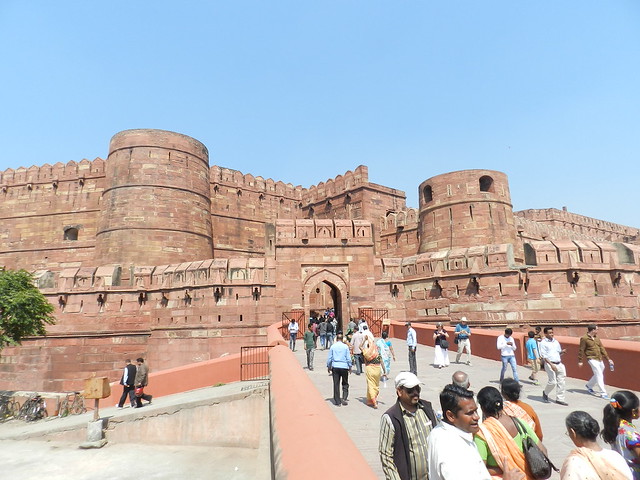(April 18 is World Heritage Day)
By Brij Khandelwal,
Agra : It’s becoming increasingly clear that only professional managers can preserve this Taj city’s heritage, experts say.
The parliamentary committee on environment, headed by former union minister Ashwini Kumar (Congress), after spot visits and interactions with stakeholders last week, expressed concern over the poor state of maintenance of even the Taj Mahal. In particular the committee pointed out the dark pockmarks on the white marble surface of the structure which urgently called for treatment. The committee members also lamented that the Taj Mahal was yellowing.
This is not the first time that concern has been expressed over the poor conservational efforts of the Archaeological Survey of India (ASI) . Experts and discerning tourists have been questioning the way the city’s historical monuments are being looked after.

“Heritage monuments in Agra are in danger. They are victims of callous neglect and corruption in the Archaeological Survey of India which has done precious little to ensure that the ageing monuments look healthy and in a better shape,” eminent Mughal historian R. Nath told IANS.
“Ritualistically celebrating World Heritage Day without doing anything tangible other than allowing ticket free entry to the monuments makes no sense as half-a-dozen recommendations of the International Council of Monuments and Sites (ICOMOS), as also of Unesco, have not been implemented,” Braj Mandal Heritage Conservation Society president Surendra Sharma told IANS.
“This special day offers an opportunity to raise the public’s awareness about the diversity of cultural heritage and the efforts that are required to protect and conserve it, as well as draw attention to its vulnerability,” he added.
The ASI in Agra has not only failed to involve the local populace in the restoration and upkeep of the heritage monuments but even its own efforts to clear most monuments of encroachments have been tardy.
Allegations have regularly been hurled against top ASI officials indulging in corrupt practices from sub-standard construction work to selling duplicate tickets to promoting black marketing of tickets. Even its expertise in conservation work has been questioned.
Local historian Raj Kishore Raje said there are dozens of structures that need immediate attention and repairs.
“Our total approach has been Taj-centric, paying very little attention to other historical monuments like Babar’s Ram Bagh or Chini ka Roza. Several important monuments including the Jami Masjid and the tomb of Rasul Shah in Fatehpur Sikri have been willfully neglected,” Raje told IANS.
Distortion of history is another serious charge against the ASI. A few years ago, a structure bearing an inscription in Persian and invocation to God was identified as Haveli Ratan Singh in the Agra Fort and pompously opened to the tourists by the then local MP, Raj Babbar.
Work on the so-called Ibadat Khana of Akbar in Fatehpur Sikri had to be abandoned when historians raised several questions about its veracity. Similarly, a fictitious structure in the Fort was identified as the jail Shivaji was lodged in by Aurangzeb. Historical records indicate Shivaji was never detained in the Fort but was perhaps lodged in a haveli now in Agra’s Jaipur House colony.
A park at the rear of the Taj Mahal distancing the Yamuna river from the monument’s foundation was thoughtlessly added, infringing on the original layout of the complex.
Perhaps the most alarming lapse has been ASI’s abject failure to rid Agra’s monuments of illegal structures and encroachments. A law passed in 1958 gives ASI sweeping powers but the ASI mandarins have never had the will to act. Most smaller protected monuments in Agra – and there are scores of them – have been virtually overwhelmed by new structures which threaten their existence.
Delhi Gate, Etmauddaula, Sikandra, Ram Bagh and dozens of others have been dwarfed by encroachments.
The World Heritage Day should be used by the ASI to present its new profile and a specific plan for restoring the grandeur of the priceless monuments that Agra is heir to. But the height of its callous apathy was exposed when it failed to take any action to stall former UP chief minister Mayawati’s controversial Taj Corridor between the Fort and the Taj.
The question now being debated in the Taj city is whether the ASI alone should have the exclusive right to restore and preserve monuments or should the-150-year-old monolithic organisation share the responsibility with other professional bodies.
Conservationists are particularly peeved at the callous indifference of the ASI headed by non-specialists – IAS bureaucrats – to take active cooperation of the local population and creating awareness about heritage and history.
Historian Nath has, in a letter to the culture ministry, suggested that a separate directorate in the ASI should be carved out to look after the managerial and administrative needs of the Taj Mahal, as distinct from the conventional conservation work.
“While specialists in the ASI should concentrate on conservation, trained professionals in hospitality, crowd management and security aspects should take care of the other visitors-specific needs,” Nath told IANS.
(Brij Khandelwal can be contacted at [email protected])

